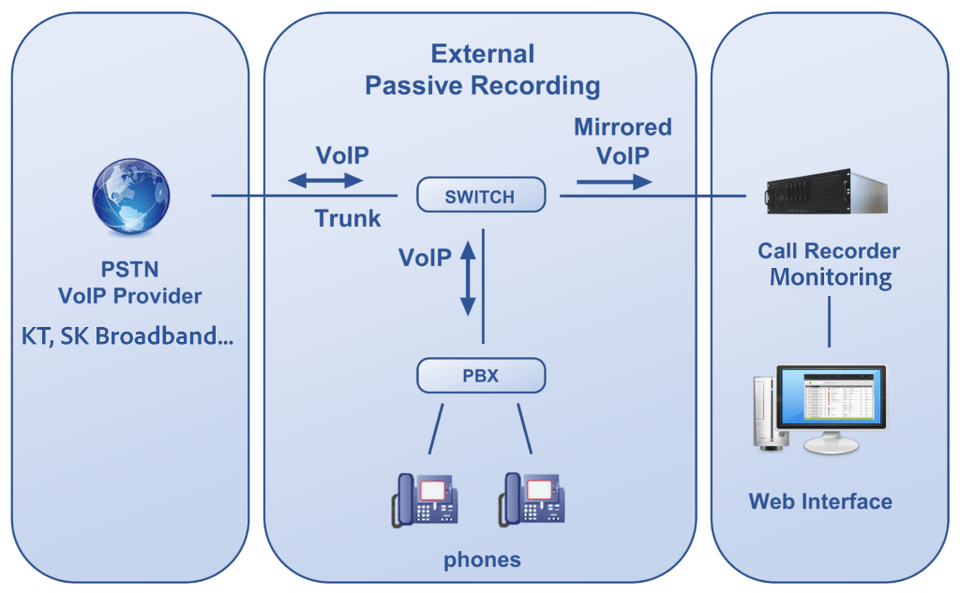Technical Notes: Port Mirroring on Switches – How to Monitor SIP/RTP without Touching Production!
— VoIP, SIP, Networking, Passive Monitoring — 2 min read
Overview
In modern call center or VoIP environments—especially those using legacy or third-party systems like CTI, Asterisk, or KT’s carrier infrastructure—it's often impossible or risky to directly inject new services like Speech-to-Text (STT) monitoring into the production path.
As a Technical Lead, my priority was to capture all SIP and RTP traffic for transcription, without impacting any part of the production call flow. The safest way to do this is using Port Mirroring (SPAN) on a network switch.
This note covers how Port Mirroring works, what hardware supports it, and how you can set up a monitoring server to sniff SIP and RTP traffic with pyshark, sngrep, or tshark.
What is Port Mirroring?
Port Mirroring, or SPAN (Switch Port Analyzer), is a feature available in managed switches that allows you to create a copy of traffic from one or more ports (or VLANs) and forward it to another port, known as the monitoring port.
This technique is passive: it doesn’t modify or delay the original packets.
Use case:
- Monitor all traffic going to/from a SIP gateway or CTI system.
- Capture both SIP signaling (port 5060) and RTP media (dynamic UDP).
- Feed mirrored traffic into a recording, STT, or analytics engine.
Which Switches Support Port Mirroring?
Most Layer 2 Managed Switches support port mirroring.
Look for terms like: SPAN, Mirror, Monitor Session, or Port Analysis in your device’s manual.
Why Port Mirroring is Ideal for SIP/RTP Monitoring
Non-intrusive: No impact on production SIP server, CTI, or Asterisk Passive recording: No ACK, INVITE, or RTP packet is ever touched Full visibility: See both call signaling (SIP) and audio (RTP) Flexible: Multiple streams can be analyzed in parallel
It’s especially useful for:
- Building a parallel STT transcription system
- Quality assurance (QA) and compliance recording
- Debugging SIP failures without altering live systems
Monitoring in Practice: Physical Setup
Here’s a practical architecture:

- Port 1: Production traffic (e.g., to/from KT SIP)
- Port 2: Mirror destination (connected to passive sniffing server)
On the monitoring server, run tools like:
1sudo sngrep -d eth02# Or pyshark3pyshark.LiveCapture(interface="eth0", display_filter="sip || rtp")📝 Note: Ensure interface is in promiscuous mode if needed.
Lessons Learned
- Not all switches support bidirectional port mirroring. Test your device first.
- Check if your server NIC supports large packet throughput (some cheap USB dongles drop RTP).
- If you see only 1 direction in Wireshark/sngrep: check switch config → mirror direction.
Conclusion
Port Mirroring is the foundation for passive SIP and RTP inspection in enterprise voice networks. Without touching or modifying any production system, you gain full insight into signaling and media flow.
This method has enabled me to roll out real-time STT monitoring on legacy CTI systems in production without any outage or risk.
I hope this guide helps other engineers looking to add AI-driven analysis, logging, or compliance tools to existing VoIP infrastructure.
Let’s build observability the right way — passively, safely, and smartly.
This article reflects real-world setups I’ve deployed as a Technical Lead. Written and structured with help from my AI assistant to enhance clarity and reusability.
